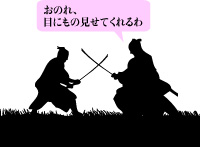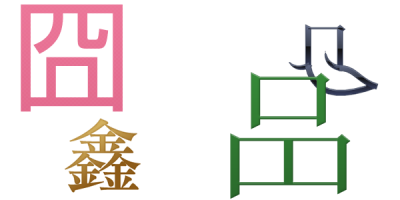
The four scales of “class,” “status,” “gender,” and “age” are important when ascertaining “Us” verbal characters, but not when ascertaining “Other” (in the broad sense) verbal characters. The very essences of “Us” verbal characters and “Other” verbal characters are different. “Us” verbal characters are not deployed “temporarily” but can be deployed naturally, and are arranged, without gaps, along the scales of “class,” “status,” “gender,” and “age.” On the other hand, we have said that “Other” verbal characters are deployed exclusively on a “temporary” basis and exist sporadically (parts 76 & 77). This division of verbal characters into the “Us” and “Other” types nicely matches the actual conditions found in language.
For example, recall the phenomenon of the “woman” character’s preference for uninflected sentences as compared with the “man.” In that case we saw that while a “man” would say ame da yo (it’s raining) a “woman” would omit the auxiliary verb da and just use the bare, uninflected ame yo (part 66).
However, there are troublesome “male” and “female” characters that contradict this observation.
Some “men” defiantly join the uninflected atarimae directly to yo ―atarimee yo (that’s obvious!) ― rather than saying atarimae da yo. Some “men” join the uninflected ore directly with yo, boasting: nani o kakusoo, sore ga kono ore yo (I’m not hiding anything ―just being myself). Some “men” join the uninflected koto or wake directly with yo as in: shireta koto yo (I already knew that!), ore no koto yo (that’s just who I am), ii tte koto yo (“no problem” in the sense of “you’re welcome”), and tena wake yo (…that’s how it is).
Ittai nanimono ka da too? (What do you mean?!) Nani itteyandee? (What are you talking about?) Kimatterai. (That’s normal.) Kochitora “Edokko” yo. (For us “Edokko.”(1)) “Atarimaeda yo” nante yuu kattenda. (I don’t use expressions like atarimae da yo.) Soitsaa, ore jaa nee. (That’s not me!) Ore no kakaa yo. (That’s my wife.)
Soo da yo omaisan. (That’s right dear.) Soitsaa atashi no kotoba da yo. (That’s how I talk.) Chotto anta, bumpooya kai? Atasha kore demo onna da yo. (Hey, Mr. Grammarian? I’m still a woman.) Negoto itteru to shoochi shinai yo. (Don’t expect us to agree with your nonsense.)
And the troublesome characters that contradict our observation are not limited to “Edokko” men and women. Another example are male characters who add the feminine wa(2) to the end of sentences ―as in ureshii wa (I’m glad). However, here I’m not talking about “unmasculine” “men,” for example the type who would say during an argument: “Even if you ask me to produce the documents at this [late] stage, it’s impossible. That would cause problems for anyone” (soryaa dare datte komaru wa). We needn’t worry about them. It is not particularly mysterious that an “unmasculine” “male” character would occasionally talk like a “female.”
The real problem is the “samurai” character who, in a blaze of temper, adds wa the end of his sentences: me ni mono misete kureru wa! (I’ll teach you a lesson!) I can just hear someone ruining our precious observation: when the “samurai” gets angry, “he adds the feminine wa to the end of his sentences. At the very least, he is not really masculine.” What a pain! I will chop you in two!
As we have seen, “Other” verbal characters differ from “Us” verbal characters on three points: “deployment method” (part 76), “state of existence” (part 77), and “spoken language” (this column). From this point of view, it is accordingly natural that we divide verbal characters into two types ―the “Other” type and the “Us” type― when considering them.
For some time (parts 57 on) I’ve been saying that we can define the overall characteristics of the various verbal characters based on the scales of “class,” “status,” “gender,” and “age.” I temporarily put aside the “Other” type characters under the proviso that we’d be focusing just on “Us” verbal characters.
* * *





![第6回 シリウタグ[踞]](https://dictionary.sanseido-publ.co.jp/wordpress/wp-content/uploads/title_kodaigo-400x200.png)



(1) Edokko refers to a commoner living in city of Edo (now Tokyo). This and the following paragraph are written in the style of Japanese used by the “Edokko” character.
(2) See part 1 footnotes for an explanation of the feminine “wa.”